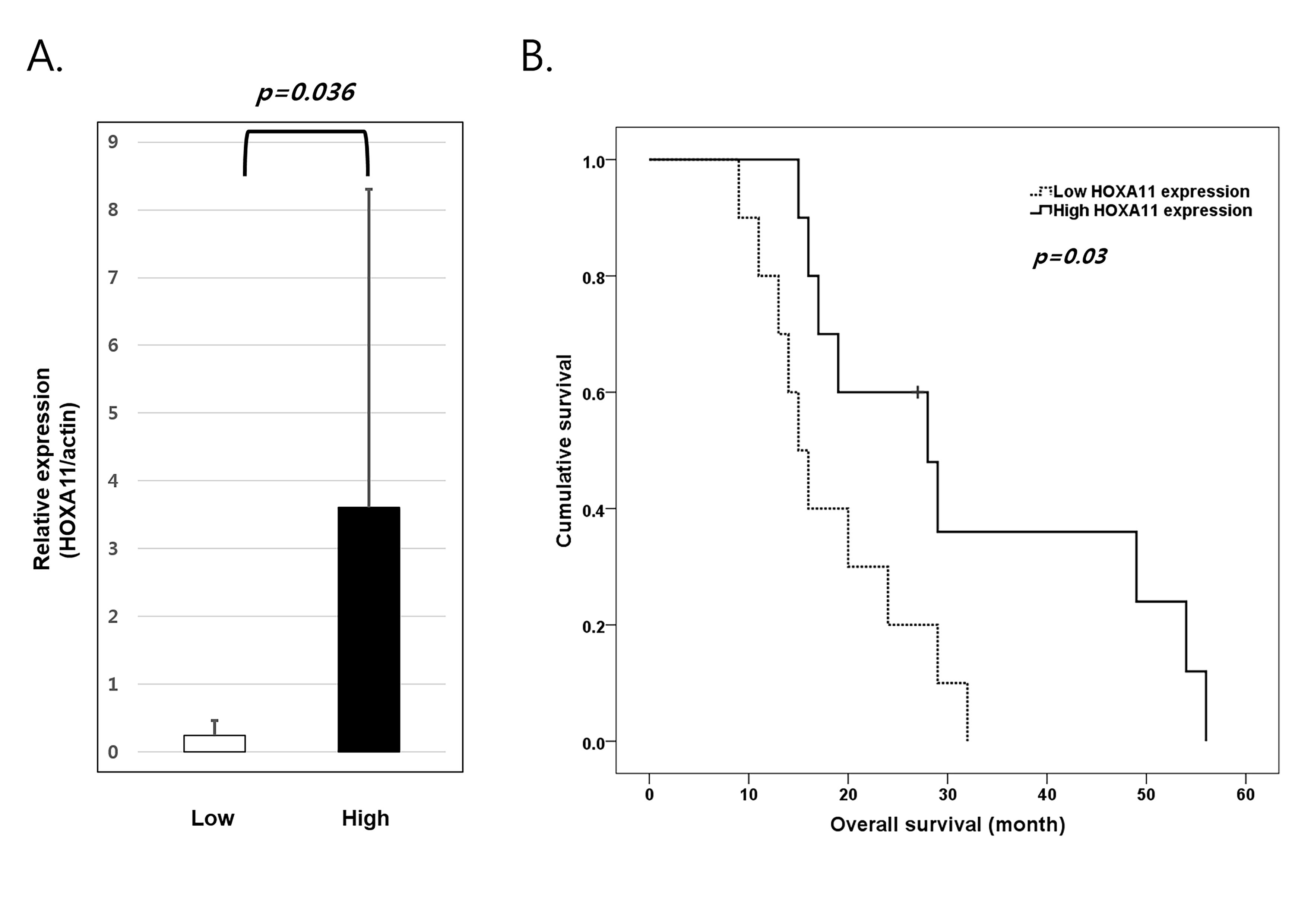글로벌 연구동향
방사선생물학
![[Cancer Res Treat.] Underexpression of HOXA11 is Associated with Treatment Resistance and Poor Prognosis in Glioblastoma.](/enewspaper/upimages/admin_20160810112132_R.jpg) 2016년 08월호
2016년 08월호
[Cancer Res Treat.] Underexpression of HOXA11 is Associated with Treatment Resistance and Poor Prognosis in Glioblastoma.서울의대/서영범, 김동규*, 박철기*
- 출처
- Cancer Res Treat.
- 등재일
- 2016 Jul 19
- 저널이슈번호
- doi: 10.4143/crt.2016.106. [Epub ahead of print]
- 내용


AbstractPURPOSE:
Homeobox (HOX) genes are essential developmental regulators that should normally be in the silenced state in an adult brain. The aberrant expression of HOX genes has been associated with the prognosis of many cancer types, including glioblastoma (GBM). This study examined the identity and role of HOX genes affecting GBM prognosis and treatment resistance.
MATERIALS AND METHODS:
The full series of HOX genes of 5 pairs of initial and recurrent human GBM samples were screened by microarray analysis to determine the most plausible candidate responsible for GBM prognosis. Another 20 newly diagnosed GBM samples were used for prognostic validation. In vitro experiments were performed to confirm the role of HOX in treatment resistance. Mediators involved in HOX gene regulation were searched using differentially expressed gene analysis, gene set enrichment tests, and network analysis.
RESULTS:
The underexpression of HOXA11 was identified as a consistent signature for a poor prognosis among the HOX genes. The overall survival of the GBM patients indicated a significantly favorable prognosis in patients with high HOXA11 expression (31 ± 15.3 months) compared to the prognoses in those with low HOXA11 expression (18 ± 7.3 months, p = 0.03). When HOXA11 was suppressed in the GBM cell lines, the anticancer effect of radiotherapy and/or temozolomide declined. In addition, five candidate mediators (TGFBR2, CRIM1, TXNIP, DPYSL2, and CRMP1) that may confer an oncologic effect after HOXA11 suppression were identified.
CONCLUSION:
The treatment resistance induced by the underexpression of HOXA11 can contribute to a poor prognosis in GBM. Further investigation will be needed to confirm the value of HOXA11 as a potential target for overcoming the treatment resistance by developing chemo- or radio-sensitizers.
Author information
Se YB1, Kim SH2, Kim JY1, Kim JE1, Dho YS1, Kim JW1, Kim YH1, Woo HG3, Kim SH4, Kang SH5, Kim HJ6, Kim TM7, Lee ST8, Choi SH9, Park SH10, Kim IH6, Kim DG1,2, Park CK1,2.
1Department of Neurosurgery, Seoul National University Hospital, Seoul, Korea.
2Department of Neurosurgery, Seoul National University College of Medicine, Seoul, Korea.
3Department of Physiology, Ajou University School of Medicine, Suwon, Korea.
4Department of Neurosurgery, Ajou University School of Medicine, Suwon, Korea.
5Department of Neurosurgery, Korea University College of Medicine, Seoul, Korea.
6Department of Radiation Oncology, Seoul National University Hospital, Seoul National University College of Medicine, Seoul, Korea.
7Department of Internal Medicine, Seoul National University Hospital, Seoul, Korea.
8Department of Neurology, Seoul National University Hospital, Seoul, Korea.
9Department of Radiology, Seoul National University Hospital, Seoul National University College of Medicine, Seoul, Korea.
10Department of Pathology, Seoul National University Hospital, Seoul National University College of Medicine, Seoul, Korea.
- 키워드
- Glioblastoma; HOXA11; Homeobox genes; Treatment resistance
- 연구소개
- 혹스 유전자(HOX gene)는 동물의 형태 형성에 관여하는 중요한 조절인자 중 하나입니다. 이러한 혹스 유전자는 성인 뇌에서는 거의 발현되지 않지만 최근 교모세포종을 포함한 여러 암종에서 혹스 유전자의 이상발현과 종양의 치료 예후와의 관련성에 대한 연구결과가 발표되고 있습니다. 따라서 본 연구진들은 이번 연구를 통해 교모세포종의 치료결과에 영향을 주는 혹스 유전자를 찾고자 하였습니다. 우선 치료결과에 영향을 미치는 혹스 유전자를 찾기 위해 초기종양 조직과 재발된 종양 조직을 비교분석하여 재발된 종양에서 HOXA11의 일관된 저발현 소견을 관찰할 수 있었습니다. 이후 HOXA11 발현 정도에 따라 환자군을 나누어 생존률을 비교하였을 때 HOXA11 저발현 그룹이 예후가 불량한 것을 관찰할 수 있었습니다. 그리고 in vitro에서 HOXA11를 유전자조절한 cell line에서 치료저항성을 관찰할 수 있었습니다. 또한, HOXA11의 저발현과 치료 저항성에 관여하는 다섯 개의 조절인자 (TGFBR2, CRIM1, TXNIP, DPYSL2, and CRMP1)를 확인할 수 있었습니다. 결론적으로 HOXA11의 저발현은 교모세포종의 치료 저항성 혹은 나쁜 예후와 연관이 있다는 사실을 확인할 수 있었고 향후 이러한 결과를 유발하는 기전에 대한 추가적인 연구가 필요함을 보고하였습니다.
- 덧글달기







